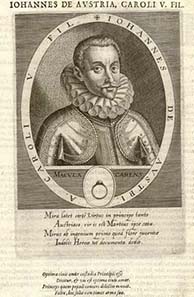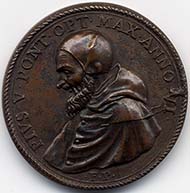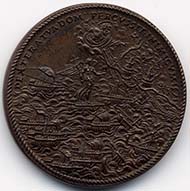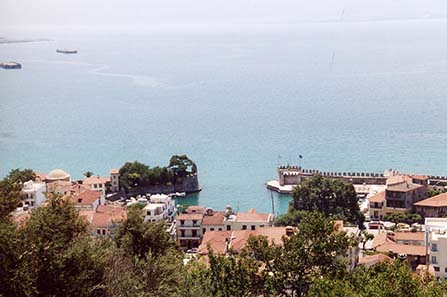On July 1st, 1571, Don John of Austria, birth son of Charles V, with his flag ship Reale took the salute the Holy League provided him with to defeat the Turks.
Don John of Austria, victor of Lepanto.
That was preceded by an ultimatum of the Ottoman sultan to the Venetians to convey away Cyprus without any delay. A self-confident Christendom, however, declined to obey. The Venetians found an ally in Pope Pius V who declared the campaign against the Turks a holy war and immediately asked all Christians to act united. Letters were sent as far as Poland and Russia, the French king and the Archduke of Austria were asked for support – but the only one who fell into line with the Holy League was Charles V of Spain.
Pius V, 1566-1572. Bronze medal to the victory of Lepanto.
Hence, on October 7th, 1571, 208 Christian galleys met 250 Turkish ships. That moment of the battle is shown on our medal. The Christian fleet comes from the left. The wind swells the canvas and the central ship depicted in the medal’s middle, carries the personification of the faith which holds a cross in the right and the chalice of the Last Supper in the left. Above God the Father is watching the scene – but he is no passive viewer, he actively intervenes. His hands send out beams hitting the enemy ships that consequently sink in heaving sea. The Latin legend interprets the scene: your right, o Lord, has hit the enemy. The battle took place 63 km west of the city of Lepanto; the medallist, however, did not bother with such geographic details: he depicts the circular harbour basin of Lepanto in the background.
Today’s view of the Bay of Lepanto.
It is bounded by two impressive corner towers still accessible to the visitor. Some small figures stand to the right on the waterfront and watch the events, terrified.
The Christians’ victory was nothing less than a triumph: after a fierce three-hour combat, 80 galleys of the Turks were scuttled, 130 were captured, and only 40 managed to escape. Lepanto was the last old-style naval battle. Although the canon had long since been invented, and ships carrying that weapon on behalf of Portugal, England and the Netherlands controlled the seven seas, Don John of Austria more or less abandoned that new technology. Outdated and outmoded Spain still clung to the “gentlemanly” art of ramming and scuttling by using a prow, a procedure introduced long ago by the Greeks into the battle at sea. Fortunately, the Ottomans did not master the new technology, either. Otherwise, the Battle of Lepanto would have witness quite a different outcome.
Santa Maria della Vittoria in Ingolstadt.
It was no huge success by and large. Although even after generations churches in the whole of Christian Europe were consecrated to Maria della Victoria (=Maria of the victory), but the success was given away before it was won. The army dissipated. The Venetians wanted to exploit the victory to strengthen their position for the negotiations about new trade privileges with the Ottoman sultan. Pope Pius V, who had brought the League together, suddenly died a year later, and the Spanish did not achieve much in the light of their power in Europe being threatened. The Turks, therefore, built up a new fleet within a few years that was in no way inferior to the previous one. “The infidels only singed my beard, it will grow in again.”, so legend has the sultan responded. His evaluation of the situation was certainly more realistic than those hysterical storms of enthusiasm the Christian victory was causing even centuries later in the different school books.








